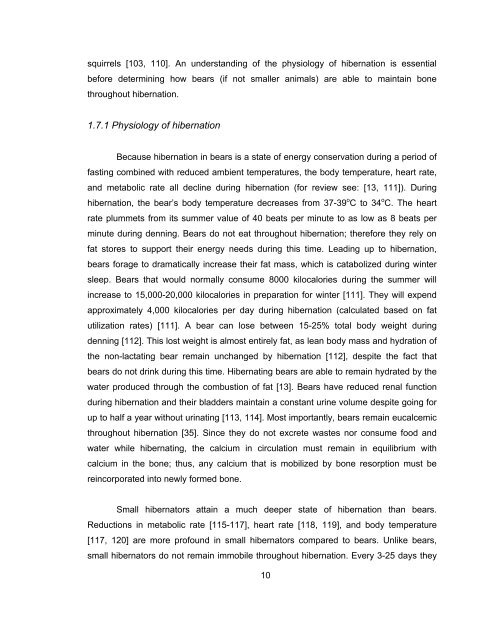C - Michigan Technological University
C - Michigan Technological University
C - Michigan Technological University
- No tags were found...
Create successful ePaper yourself
Turn your PDF publications into a flip-book with our unique Google optimized e-Paper software.
squirrels [103, 110]. An understanding of the physiology of hibernation is essentialbefore determining how bears (if not smaller animals) are able to maintain bonethroughout hibernation.1.7.1 Physiology of hibernationBecause hibernation in bears is a state of energy conservation during a period offasting combined with reduced ambient temperatures, the body temperature, heart rate,and metabolic rate all decline during hibernation (for review see: [13, 111]). Duringhibernation, the bear’s body temperature decreases from 37-39 o C to 34 o C. The heartrate plummets from its summer value of 40 beats per minute to as low as 8 beats perminute during denning. Bears do not eat throughout hibernation; therefore they rely onfat stores to support their energy needs during this time. Leading up to hibernation,bears forage to dramatically increase their fat mass, which is catabolized during wintersleep. Bears that would normally consume 8000 kilocalories during the summer willincrease to 15,000-20,000 kilocalories in preparation for winter [111]. They will expendapproximately 4,000 kilocalories per day during hibernation (calculated based on fatutilization rates) [111]. A bear can lose between 15-25% total body weight duringdenning [112]. This lost weight is almost entirely fat, as lean body mass and hydration ofthe non-lactating bear remain unchanged by hibernation [112], despite the fact thatbears do not drink during this time. Hibernating bears are able to remain hydrated by thewater produced through the combustion of fat [13]. Bears have reduced renal functionduring hibernation and their bladders maintain a constant urine volume despite going forup to half a year without urinating [113, 114]. Most importantly, bears remain eucalcemicthroughout hibernation [35]. Since they do not excrete wastes nor consume food andwater while hibernating, the calcium in circulation must remain in equilibrium withcalcium in the bone; thus, any calcium that is mobilized by bone resorption must bereincorporated into newly formed bone.Small hibernators attain a much deeper state of hibernation than bears.Reductions in metabolic rate [115-117], heart rate [118, 119], and body temperature[117, 120] are more profound in small hibernators compared to bears. Unlike bears,small hibernators do not remain immobile throughout hibernation. Every 3-25 days they10
















